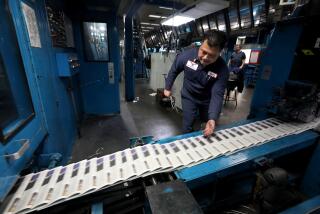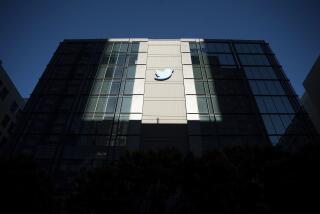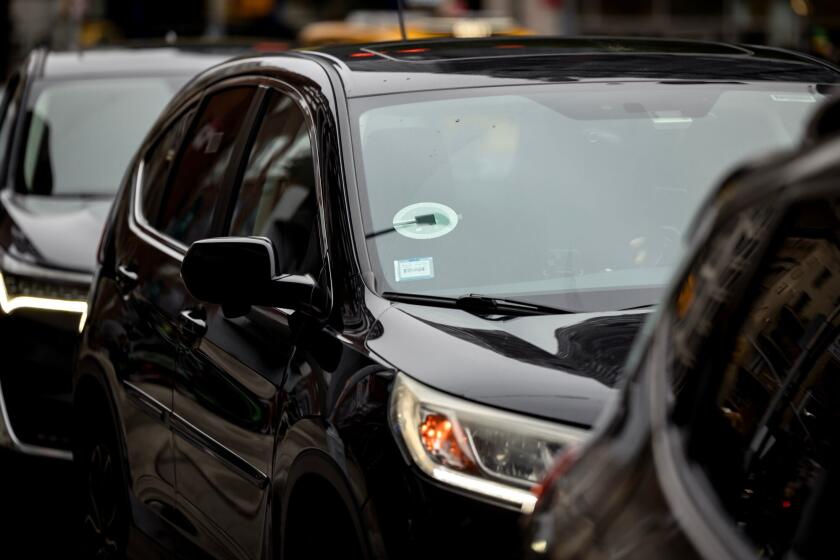Financial Times charges into future
- Share via
At Bar Marmont late Monday and into Tuesday’s wee hours, the Chivas flowed, tuxedo ties came loose and conversation burbled. Executives for some of the world’s top luxury brands made the scene, along with guests of … what’s that? … a newspaper?
Yes, a newspaper — or, more accurately, a multi-platform journalistic enterprise — brought investors, marketers, entrepreneurs and other luminaries together this week to rub elbows and consider subjects such as overcoming extravagance guilt and “the narrative behind the luxury purchase.”
In the epochal struggle to sustain journalism, there has been a lot of talk about preserving mass. But the London-based, internationally read Financial Times has spent more time worrying about building class.
From events like this week’s FT Business of Luxury Summit to its insistence on charging for regular access to its website, the British publishing enterprise has tried to make itself the preferred watering hole for the most elegant business beasts.
The strategy appears to be working. Though it doubled its print circulation prices within the last 18 months (now $348 a year in the U.S.) and a few years ago became one of the few news sites to charge for online access (now starting at $186 a year), the Financial Times has seen subscription revenues grow.
The company expects this year that direct payments for its journalism will exceed print advertising revenue, that wheezing engine that still sustains almost every other newspaper. While other publishers have struggled to make 10% of their revenue online, the Financial Times projects that its digital work will create one-third of its revenue by 2012.
“Some of the apostles of free — who were giving us a hard time three or four years ago when we started charging online — are no longer in business,” said John Ridding, the urbane onetime reporter who is now the Financial Times’ chief executive. “I have a fundamental belief that quality journalism is worth paying for and that people will pay for it.”
Although it won’t reveal just how much it’s making, the 550-journalist news outlet (roughly the same staffing as the Los Angeles Times) has also profited and strengthened its high-end brand by hosting more than 50 meetings and conferences a year. They dot the globe, from Monaco to Beijing.
The Business of Luxury Summit, now in its sixth year, has become the flagship event, and a handsome moneymaker because of tony sponsors like Jaguar and Lebua Hotels & Resorts and support from about 350 “delegates,” who pay from $2,200 to $3,195 to spend two days with business icons like Diane von Furstenberg and Leonard Lauder, chairman emeritus of the Estee Lauder Cos.
Also on the agenda this Monday and Tuesday at the Beverly Hills Hotel — Disney boss Robert Iger, Creative Artists Agency poohbah Bryan Lourd, Calvin Klein Chief Executive Tom Murry, Van Cleef & Arpels exec Nicolas Bos and Jimmy Choo founder Tamara Mellon.
Lauder said he was willing to fly from Paris to deliver a keynote so he could spend time with other executives he respects. He hoped to inspire and be inspired. “America has been built on ideas,” he said in an interview on a sunny patio lined with banana trees. “When we stop seeking out new ideas, that’s the end.”
Like most of the other speakers, Lauder said he did not receive an honorarium nor did the Financial Times pay for his flight. It’s that sort of economy combined with the high entry fee and corporate sponsorships of $25,000 and much more that help Financial Times special events produce profit margins of 40% and more.
Bradford Rand, a luxury-showcase and special-event producer, said the Financial Times’ luxury event has special allure because it’s not for everyone. He and many others at the conference normally would have struggled to pass the velvet rope at the hipster Bar Marmont.
“There were no rock stars there last night, but I think people who went felt like rock stars,” Rand said. “There were heads of companies and top marketing people.… You are getting real access. That’s what people pay for.”
The privileged access regimen extends to the Financial Times’ website. The outlet does not charge for the first 10 visits to the site, with the reader required to subscribe after that. More than 126,000 readers have, some for premium $299 subscriptions that come with extra updates. That’s 15% more paid users than a year prior.
Most publishers fear that if they adopt a paid site, readers will shrink away and, with them, advertising revenue. But by registering its online users and being able to show their high-end, free-spending ways, the Financial Times has been able to justify higher ad rates.
“I think in general journalists and analysts have been too worried about ‘volume metrics,’ circulation numbers,” said Ridding, a former foreign correspondent, who speaks in the sort of expansive terms that make strong news people feel the sentiment of times past. It’s about total readership and it’s about engagement” with a quality audience.
Many other newspapers, including the New York Times and the Times of London, plan to begin charging for online content. The New York Times said it will erect a paid wall next year.
But will the people pay for content that until now has been almost entirely free?
The Financial Times and Wall Street Journal, which also charges to read its digital edition, have a clear advantage because they cover specialized subject matter that many business people believe they can’t get elsewhere. Employers often pay for the subscriptions. Many people write off the cost of the publications on their income tax as a business expense.
Despite those advantages, Ridding insists more general newspapers have been “too slow and too timid” about charging for the unique information they produce.
It was not just the newspaperman, once posted to Paris and Hong Kong and now based in London, who argued for the unique value of traditional journalism. Jonathan Newhouse, chairman of the Conde Nast magazine empire, told the conference that the cacophony of voices on the Internet made brand names like Vogue “count more than ever.” Von Furstenberg told the stylish crowd that “the value of editors will only increase.”
It’s almost to the point, Ridding contended, that publishers don’t have a choice. “They kind of have to charge,” he said, “because advertising alone is not going to sustain the kind of professional newsrooms that news organizations need and that readers expect.”
We really want everyone inside the velvet rope, you see. But the day may be coming when Club Journalism is no longer free.
Twitter: latimesrainey
More to Read
Inside the business of entertainment
The Wide Shot brings you news, analysis and insights on everything from streaming wars to production — and what it all means for the future.
You may occasionally receive promotional content from the Los Angeles Times.











